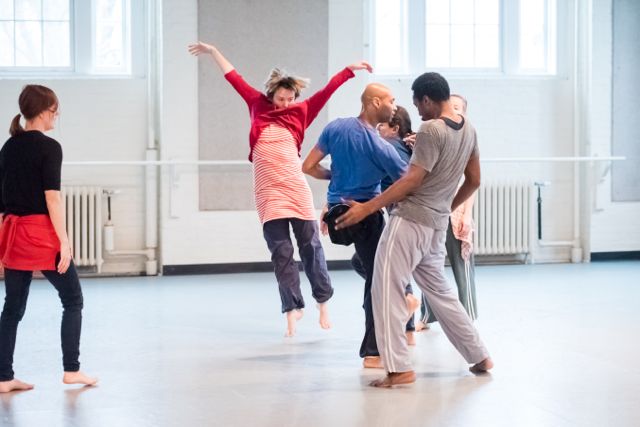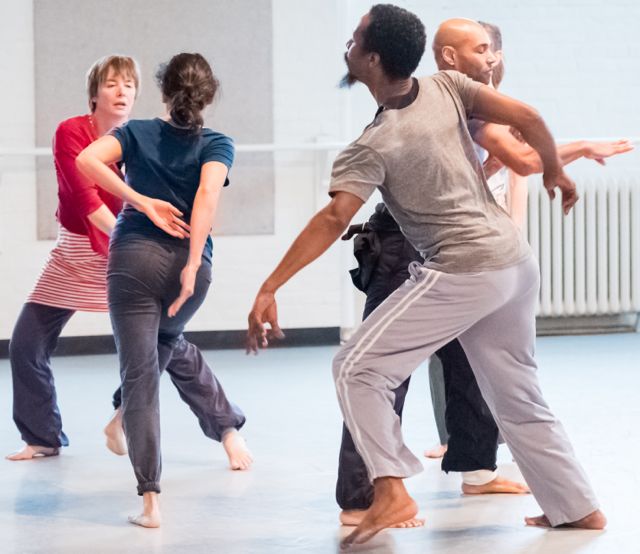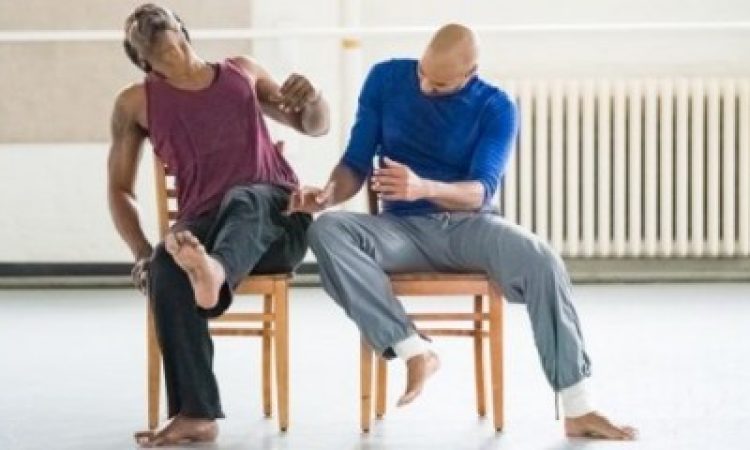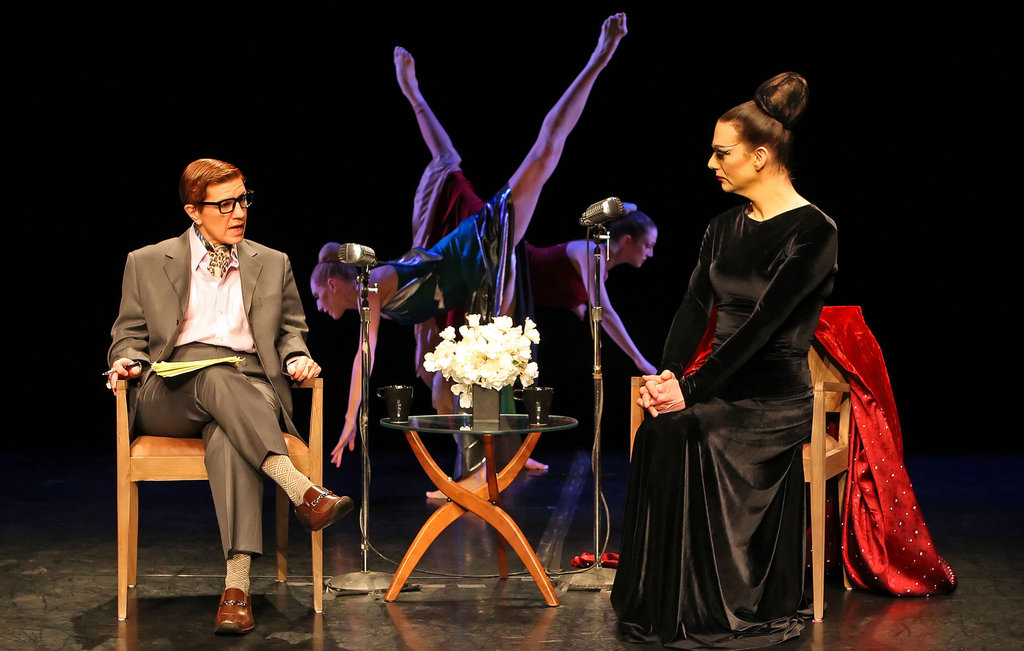Making
Inside the Scott Studio at Smith College in Northampton, MA, Darrell Jones and Trebien Pollard are dancing a mysterious dance. They twist their bodies reciprocally, as though they were each others’ unrecognizable images, reflected through a distorted mirror. A hair’s distance apart, they tangle torsos and necks, oscillating like two magnets with shifting poles. The men pause, holding their shape while stealing a glance at each other and exchanging murmured words, before slackening. Beginning again, they trace a blurred trajectory of where they had once been, approaching something like repetition without quite arriving.
Behind them, Sarah Gamblin is immersed in a solitary world, appearing far away in the wide, bright studio. She refines angular arms and spiraling torso for close to an hour, her increasing sweatiness evidence of passing time. To the right, Michelle Boulé, Angie Hauser, and Bronwen MacArthur are trio-ing, calibrating seemingly independent phrases to carefully intersect. It’s mostly quiet, save the irregular sounds of sliding feet, clothes and skin brushing the floor, and the occasional soft discussion bubbling up, sometimes erupting into laughter before settling down into quiet once more.
The scene has cadence and logic. The variable rhythms and approximated repetition all add up to the familiarity of rehearsal. The thinking process seems exposed, clear as day. Causality shows up in a manner distinct from its appearance in a performative moment, when— though still sometimes visible—its edges may be smoothed. Here in the studio, all are engaged and activated, tuned towards heightened listening for an unexpected event to show itself, something that might lead to a chain of events that would remain otherwise dormant. On this particular Wednesday, I watch it unfold, this dance of becoming. I know that it won’t happen again, at least in quite the same way.
The Making Room is a project by Bebe Miller and Susan Rethorst, aimed at investigating “innovative ways of sharing the creative process from start to premiere.” They, along with company members, were in residence at Smith College in January, their work culminating in a showing at the School for Contemporary Dance and Thought in Northampton. It was their third in-person convening since this project was initially conceived about a year and a half ago, when Miller began to think about her next project and found herself wondering, What else happens besides performance? How do we look at our process? What about other people’s processes?

Icebergs
The next evening, I am among audience members at the School for Contemporary Dance and Thought. Miller’s six dancers weave through each other, momentarily arriving in a circle before dissolving their spatial relationship, jabbing their limbs through space. They come close to the audience and face us, shoulder-to-shoulder, and begin to disintegrate into disfigurement, all the while whispering to each other slyly. Leonard Cohen comes over the sound system, his deep monotone augmented into a stuttering loop. Next, Gabrielle Revlock and Michelle Stortz perform a duet by Rethorst, at first intricate and detailed as Stortz opens and closes her fingers exactly, simultaneously. Then flustered and edging towards slapstick, Revlock comes near the audience, obscures Stortz and steals a slow, furtive glance over her shoulder as tinny music reminiscent of old cartoon theme songs plays. For an experiment in framing, Miller’s and Rethorst’s works are then performed simultaneously, familiar images layering and slipping over one another like the act of remembering itself.
Over the course of the residency, I visited three rehearsals, and at the showing on Thursday evening, I found myself thinking about all that remains unseen in a performance and all that disappears in the making of a dance. A visible product—in dance, traditionally, a performance or showing—is exposed. But submerged below the surface is a much larger, possibly unknowable, unquantifiable mass comprised of rehearsals, fundraising, failures, conversations, arguments, omitted material, injuries. This mass of experience, the phenomenology of performance, all makes up a shadowy underbelly of the performative moment. The visible product, the tip of an iceberg, is supported by unseen experience, remaining mostly obscured. In many ways, The Making Room seems aimed at finding ways to expose these shadowy places, and to use them as content.
Movement is one fractal amidst a larger entity when considering dance’s meaning. I spoke with Miller after the residency and discussed her interest in syntax, or the way meaning is created when two entities are placed side-by-side. Just as in writing, where there can be implied meaning in the way that two words are put together, there is also meaning that emerges from between visible movements, peeking through, authored by the thinking, feeling, experiencing dancer.
The challenge of capturing these shadowy moments of what wants to disappear, falls largely to video artist Lily Skove. She is taking part in the project as “register and translator, documenting each convening as witness to the process.” During our discussion, Miller described the way in which Skove is thinking about documentation as capturing the ways in which she, Rethorst, and the dancers are paying attention, capturing the tone of material, rather than what might be purely visible. “The absence of product as product,” she says. “The capture of process is not what is that body doing in the corner of the studio, but maybe some change, some other time-frame, the spiraling of an idea that then shoots off, and you capture that.”

Change
During the first rehearsal I visited, Miller was improvising and the dancers were catching and approximating her movements while Nelly’s Country Grammar played over the sound system. Working sequentially, a movement phrase became stitched in real-time. Miller’s movements sifted through each of the dancer’s bodies in varied ways, the residue of her improvising sticking and imprinting in as many different ways as there were anatomies in the room. I sit for an hour, reveling in the meandering of it, watching something fickle, messy, and unknown taking its time to come into being, taking the non-direct route.
How do you capture something that’s constantly changing? In addition to a public event that will take place at New York Live Arts in February 2018 (outside the original aim, Miller notes) there will be an ebook and a website generated as part of The Making Room. By creating fixed documents that evade the ephemeral, flash-in-the pan moment of performance, there is the invitation for returning, and in that returning, for finding new meaning, perhaps an invitation for the audience to witness their own change over time.
Though it could perhaps be said that our icebergs have long been melting, it is undeniable that we’ve now been hurtled into an environment where they are in dire peril. We will need many strategies for keeping our performative forms and corporeal practices alive, including clinging to our disappearing icebergs, fighting for their survival in a world in the midst of rupture. Projects like The Making Room remind me of the ways we can also try to evade the seduction of arrival. How can we use dance and performance to reflect something more like the way we live, the way we watch time pass, the way we experience change?
The Making Room, Bebe Miller and Susan Rethorst, The School for Contemporary Dance and Thought, Smith College, Northampton, MA, Jan. 19






